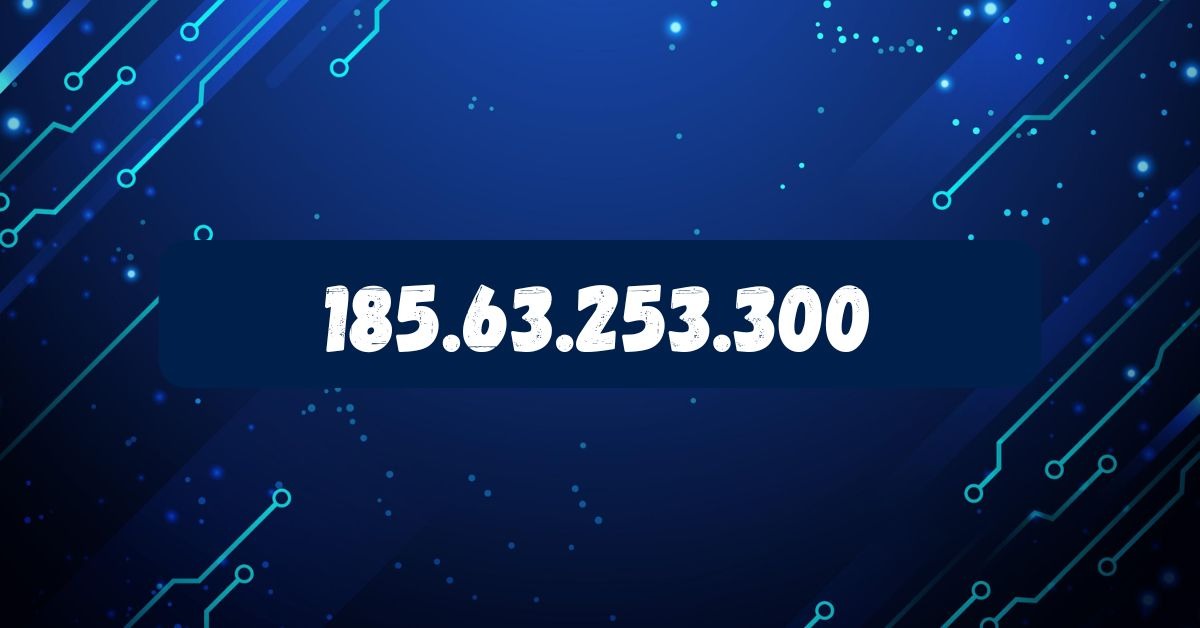In today’s hyper-connected world, IP addresses are the invisible highways of the digital realm—guiding your emails, search queries, video streams, and financial transactions to their intended destinations. But what happens when an IP address doesn’t play by the rules?
Take, for example, 185.63.253.300. At first glance, it looks like a standard IPv4 address. But it’s not. This one is technically invalid—and understanding why opens a window into how the internet really works, from protocols and packet routing to cybersecurity and network administration.
Let’s break it all down—from what makes an IP address valid, to the deeper implications of a seemingly simple numerical mistake.
What Is 185.63.253.300?
185.63.253.300 appears to be a standard IPv4 address, a format used widely in the internet’s infrastructure. IPv4 addresses consist of four numbers (called octets) separated by dots, each ranging from 0 to 255.
- Format:
A.B.C.D - Example:
192.168.1.1 - Valid Range for Each Octet:
0 – 255
So, what’s wrong here?
Let’s examine:
| Octet Position | Value | Valid? | Reason |
|---|---|---|---|
| 1st | 185 | ✅ | Within 0–255 |
| 2nd | 63 | ✅ | Within 0–255 |
| 3rd | 253 | ✅ | Within 0–255 |
| 4th | 300 | ❌ | Exceeds max value (255) |
Verdict: Invalid IP Address
Because the final octet is 300, 185.63.253.300 is not a valid IPv4 address. It cannot be assigned to any network device, routed through the internet, or used for legitimate communication.
What Makes an IP Address Valid?
An IP (Internet Protocol) address acts like a mailing address for your digital devices. It ensures that data packets reach the right destinations across the internet.
🔸 Two Main IP Formats:
| Type | Format Example | Bit Size | Max Addresses |
|---|---|---|---|
| IPv4 | 192.168.0.1 | 32-bit | ~4.3 billion |
| IPv6 | 2001:0db8:85a3::8a2e:0370:7334 | 128-bit | ~340 undecillion |
IPv6 was introduced due to IPv4 exhaustion but hasn’t been universally adopted yet.
Can We Trace 185.63.253.300?
Even though 185.63.253.300 is invalid, let’s assume for a moment it were a typo. If corrected to something like 185.63.253.255 or 185.63.253.200, we could attempt a WHOIS or IP lookup to gather insights.
IP Lookup Reveals:
| Parameter | Description |
|---|---|
| Country | Likely within Europe (185.63.x.x often falls under RIPE) |
| ISP | Depends on allocation (e.g., hosting provider or telecom) |
| Organization | Could be linked to a data center or enterprise |
| WHOIS Info | Name, address, and contact of the registered IP block |
Note: Invalid IPs return no location, no provider, and trigger errors in traceroutes or domain resolution tools.
Common Reasons Invalid IPs Like 185.63.253.300 Appear
| Cause | Description |
|---|---|
| Typos | Human error while entering or copying an IP |
| Placeholder | Used in tutorials, tests, or documentation without intent for real use |
| Spoofing | Cybercriminals may use fake IPs to mask origins during attacks |
| Misconfigured Devices | Software bugs or misassigned ranges can assign invalid IPs inadvertently |
Security Implications of Invalid IPs
Even though 185.63.253.300 can’t be used for legitimate traffic, its misuse can have real-world consequences.
🔐 Security Risks:
- IP Spoofing: Attackers fake IPs to hide their location.
- Botnets: May attempt connections using fake IPs.
- DDoS Attacks: Invalid IPs in logs may signal probing behavior.
- Blacklists: Repeated appearance of bad IPs can lead to server blacklisting.
Best Practices: Validating IP Addresses
Before using any IP address in software, config files, firewalls, or access logs, ensure it’s valid and clean.
Tools You Can Use:
- Python Validation Script:
pythonCopyEditimport ipaddress
try:
ip = ipaddress.ip_address('185.63.253.300')
print("Valid IP")
except ValueError:
print("Invalid IP")
- Online Tools:
- MXToolbox
- IPVoid
- WHOIS.net
📊 Table: IPv4 vs IPv6 at a Glance
| Feature | IPv4 | IPv6 |
|---|---|---|
| Bit Length | 32-bit | 128-bit |
| Format | 192.168.1.1 | 2001:db8::ff00:42:8329 |
| Address Count | ~4.3 billion | ~340 undecillion |
| Launched | 1981 | 1998 |
| Exhaustion | Near depleted | Vast space |
| Security | Manual integration required | IPSec built-in |
Investigative Steps If You Encounter IPs Like 185.63.253.300
- Run a WHOIS Lookup: Check if it’s part of a known IP block.
- Review Logs: Note repeated access attempts or failed connections.
- Check Blacklists: Use threat intelligence tools.
- Consult Security Teams: If unsure, get expert analysis.
- Avoid Using in Production: Never hardcode or deploy with invalid IPs.
Final Thoughts
The IP address 185.63.253.300 may be invalid—but it’s far from meaningless. It’s a teachable symbol for understanding how critical precision and structure are to the internet’s backbone.
Whether you’re managing a home network, configuring enterprise firewalls, or learning about cybersecurity, the takeaway is clear:
Even one wrong digit can break the entire system.
Stay vigilant. Validate everything. And remember—every byte matters in the digital world.

Leave a Reply